The term cleaver, is the name given to big, heavy knives that are mainly used for chopping through meat and bone. While it’s commonly seen as a butcher’s tool, the humble cleaver is a knife that almost every kitchen could benefit from.
Cleavers are not just for professionally dressing a cut of meat, but also for prepping fruit and veg, fish, and dozens more jobs. Once you realized the versatility of them, it’ll be a tool that you’ll find yourself reaching for again and again.
Cleaver can also mean many different things, depending on where you’re from. This article breaks down the difference between Western and Asian style cleavers, what they’re used for, and which one is the right choice for your kitchen.
Table of contents
Why you need a cleaver
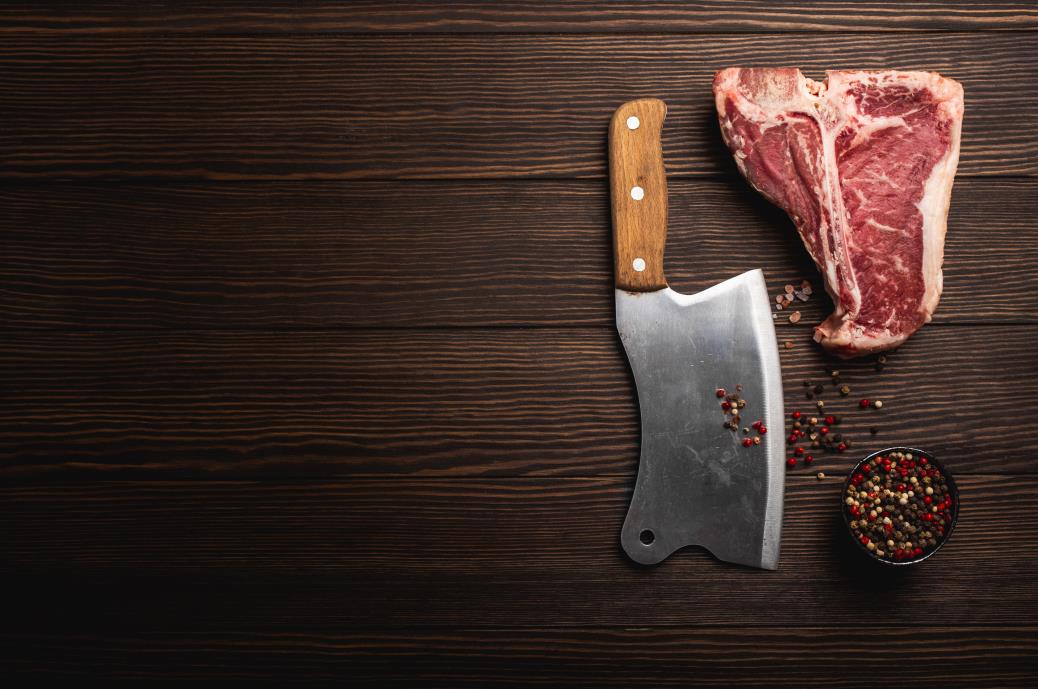
The large, square blade of a traditional cleaver is designed to be thicker and heavier than most other knives. The design helps it to chop through large cuts of meat or smash through bone with less risk of slowing down, or the blade dulling.
Traditional meat cleavers are supposed to cut through large joints of meat, chicken breast and big fish without having to worry about deflecting the blade. They are also incredibly robust tools that are easy to keep sharp, and will last years if looked after correctly.
But it’s the versatility of a cleaver that keeps chefs and other kitchen professionals reaching for them. As well as preparing meat, cleaver-style knives are perfect for chopping or dicing heavy fruits and vegetables, for example butternut and other squashes, or large quantities of big root veg.
The large, flat blade of a cleaver is also perfect for pounding or crushing things like herbs. And the flat, broad cutting edge makes scraping diced herbs or the contents of a cutting board straight into a bowl incredibly simple.
But not all cleavers are made equal. The most important thing you need to understand when buying a cleaver is that some are designed for specific jobs around the kitchen, so when you’re purchasing a cleaver, it’s important to understand exactly what you’re buying.
Handpicked for you
True cutting power in the palm of your hand
What are the different types of cleavers?
Western Cleavers
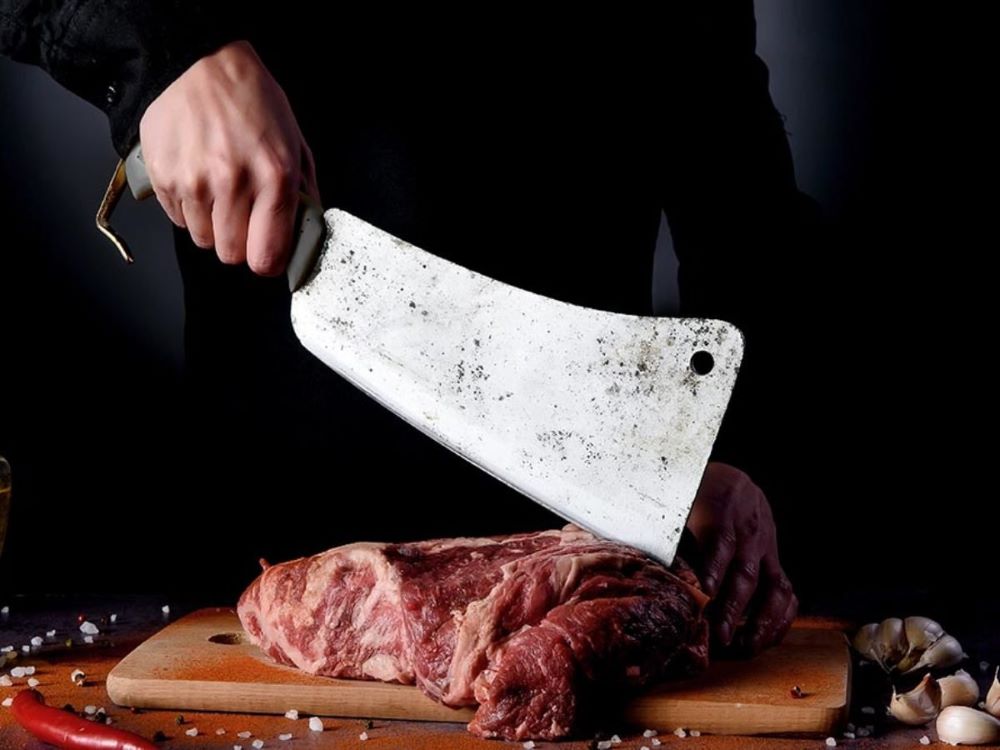
So far, this article has mostly covered western cleavers, because that’s what most English speakers will be familiar with, and the first thing that comes to mind when the name is mentioned.
Western cleavers share a list of common features that help identify this type of knife:
- A large, square- shaped, heavy blade. The back edge of the blade is very thick and tough, which helps to keep the knife stable and prevent damage.
- A long and flat cutting surface, with very little or zero curve. The blade edge is normally kept less sharp than most knives, because a lot of the cutting power of a cleaver comes from weight and momentum.
- An offset handle, traditionally wooden, but modern cleavers might also use polymer or other materials. (Offset means the handle is attached to the reverse edge of the blade, opposite to the cutting surface, instead of in the middle of the blade for balance. )
Why buy a western-style cleaver?
Meat cleavers are designed mainly to chop meat. As a butcher’s tool, they’re incredibly good at this one job, and not suited for many others.
If you commonly prepare a lot of meat dishes, or you buy full joints of meat to freeze and prep from home, a cleaver is an ideal tool for your kitchen.
A western cleaver can come in many shapes and sizes. For more help making a choice, refer to the guide at the end of this article.
Japanese cleavers
The Nakiri
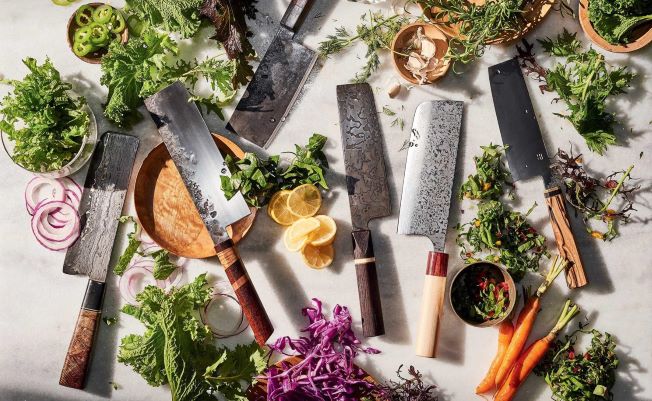
A Nakiri cleaver, or Nakiri Bocho (lit. knife for cutting greens) looks very similar to a Chinese style cleaver at first glance. All Nakiri have smaller, squared-off blades with little to no point and a flat cutting edge.
But the name itself tells you exactly what the blade is for. A Nakiri is designed for cutting vegetables, and everything about the way these knives are made lends itself to that.
Firstly, Nakiri knives tend to be lighter and smaller than most cleaver blades. This makes the blade much easier to handle, and much quicker in the hand, which makes a big difference when you’re finely chopping greens and working fast in the kitchen.
Second, the blade of a Nakiri is thinner than other cleavers, with a far sharper, but more delicate edge. This lets a Nakiri slice effortlessly through thicker vegetables using the rapid up-and-down chopping motion common in a lot of Asian cuisines.
Nakiri are not designed to cut meat. The lighter weight requires more force to cut through a thick joint of meat, and the delicate blade isn’t suitable for cutting through bone, and is liable to chip or turn.
The Chukabocho
The name Chukabocho means Chinese (Chuka) style kitchen knife (Bocho.) A Chukabocho knife is basically an identical copy of a Chinese cleaver, except it has been made using Japanese steel forging methods.
Most Chukabocho are lighter and smaller than a Western-style cleaver, despite having the same squared-off general shape. This is because a knife like this is designed for general use, rather than as a dedicated meat cutting tool. Chukabocho should be treated more like a standard chef’s knife than as a cleaver, as your go-to knife around the kitchen, useful for preparing a wide variety of dishes.
Chukabocho vs Chinese cleavers
As already mentioned, the name Chukabocho is a literal translation in Japanese for Chinese kitchen knife. It’s the Japanese variant of the Chinese cleaver, and the differences are relatively minor.
Types of Chinese cleaver
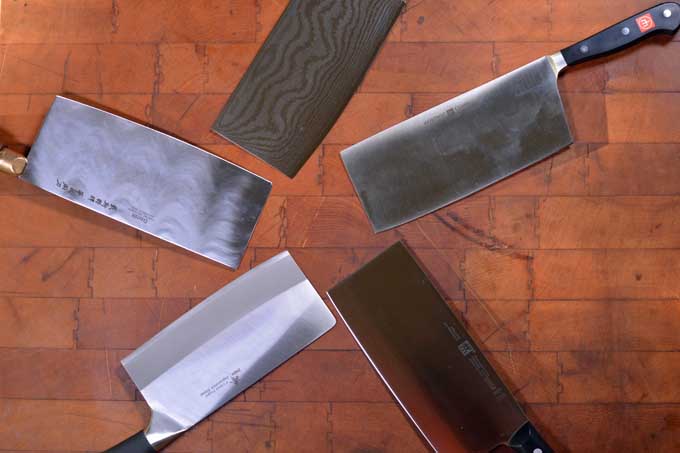
Many Chinese knives resemble cleavers, with large, square blades that lack a pointed tip. The general term for Chinese kitchen knives is the Cai Dao, and it can be used to describe many different knives, but is most commonly used to describe a ‘standard,’ general-use style of vegetable knife.
Cleaver-style Chinese knives can be split into three general varieties, based on the blade thickness and what the knife has been designed to do.
The Chinese vegetable cleaver
The Chinese vegetable cleaver or knife, occasionally referred to just as a Cai Dao, might look similar to a Western cleaver, but doesn’t handle like one. The most common knife in Chinese households, and sometimes the only knife that ever gets used, the vegetable cleaver has a more delicate blade with a lighter profile and a thinner, sharper edge.
Unlike knives designed to cleave through bone, the vegetable cleaver is a much more generalist knife that a Chinese chef will reach for again and again. Suitable for cutting vegetables, as the name suggests, cleavers of this type are also excellent for mincing herbs and other leafy greens and slicing prepared cuts of boneless meat into smaller portions.
Why buy a vegetable cleaver?
A vegetable cleaver is a fantastic knife for general use around your kitchen. If you’ve never used one before, learning the cutting motions required might take a little work, but once you’ve mastered the use of a Chinese cleaver, there are very few jobs that this versatile tool isn’t suited for.
The Chinse dual-purpose (or all-purpose) Cleaver
Sometimes called an All-Purpose Knife, or a Chopper, a dual-purpose cleaver has a blade that’s thicker and stronger at the heel than a vegetable cleaver, which means it’s much more suitable for the preparation of meat dishes, especially fish and poultry.
Everything about a dual-purpose cleaver’s design speaks to its ability to handle any job. The knife is narrower and more delicate nearer the front of the blade, making it easy to maneuver and perfect for thin slicing. Whereas the back of the blade is much thicker, with a tough spine that puts the weight and balance nearer the hand, and makes chopping through small bones relatively easy.
Why buy a dual-purpose cleaver?
An all-purpose cleaver, as the name suggests, is useful for most roles around the kitchen, but can be a complicated tool to master if you’re not used to it.
We would recommend leaning towards a Chinese vegetable cleaver before buying an all-purpose cleaver, and only consider buying one if you prepare a lot of meat dishes.
The Chinese meat cleaver
The Chinese meat cleaver, also called the Gudao (which means “bone cleaver,” or “bone chopper,”) is a knife that’s used for exactly what its name suggests it should. It is a much heavier knife with a thicker blade that’s designed for the same job as a Western cleaver; cutting through meat and bone with the minimum of resistance.
What to consider when choosing a cleaver
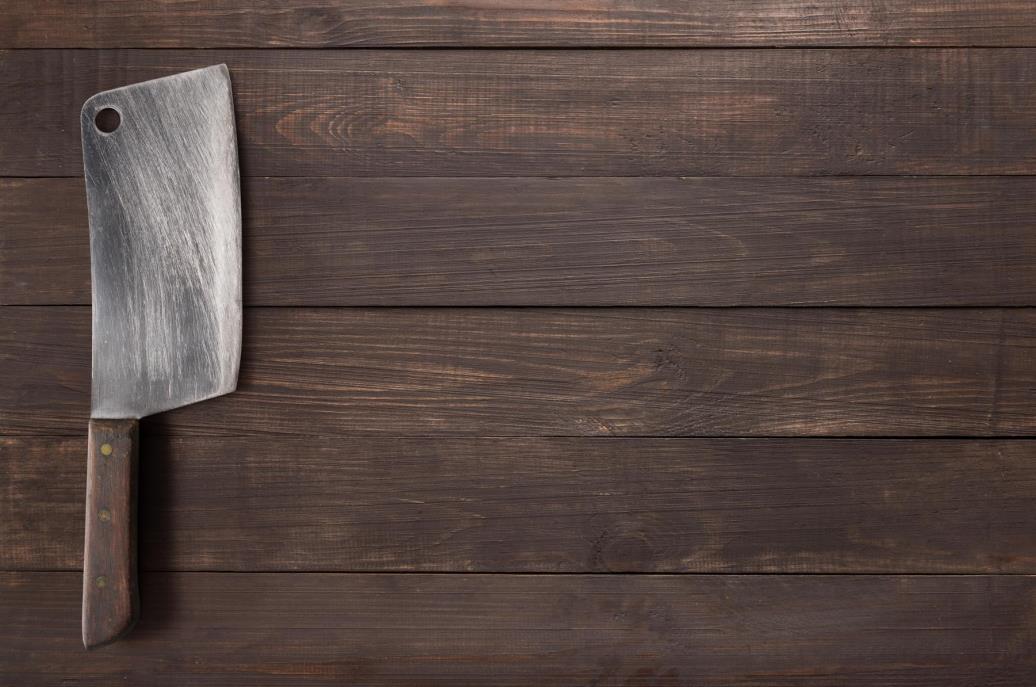
What is it going to be used for?
The single most important consideration when you’re buying a cleaver is this: What are you buying it for?
If you are buying a cleaver specifically to cut meat, and you already have knives in your kitchen that you can use for most jobs, then buy a Western meat cleaver, or a Chinese Gudao.
If you’re looking to buy a cleaver that also serves as a multi-role knife for the kitchen, similar to the way a chef’s knife can normally be used, then you should consider an Asian style cleaver like a Cai Dao or Chukabocho.
Blade material
What the blade of a knife is made from can have a big impact on its performance in the kitchen.
The two main materials used to make knives are stainless steel, and high carbon steel.
Stainless steel is popular because it’s a lot cheaper than high carbon steel, as well as being much easier to look after. Stainless steel is corrosion and rust resistant, so you won’t ruin the blade if you leave it a little damp. The edge lasts longer, and is also simpler to keep sharp, and to sharpen.
Stainless steel is a great material for cleavers specifically because of these factors. A cleaver doesn’t need the sharpest blade, and most cleavers will face heavy use, so a knife that’s a little more robust is a good choice.
High carbon steel is the hardest variety of steel there is. A high carbon knife can be much sharper than an equivalent stainless steel blade, but the increased carbon content makes the blade harder to look after, as it’s more likely to chip or break.
But as long as you look after a high carbon steel cleaver, it’s a tool that’s going to perform incredibly well at the job you need it to do; easily chop through big joints of meat. And for more general purpose knives like Nakiri or Cai Dao, a high carbon steel knife is a fantastic choice.
Handle size and design
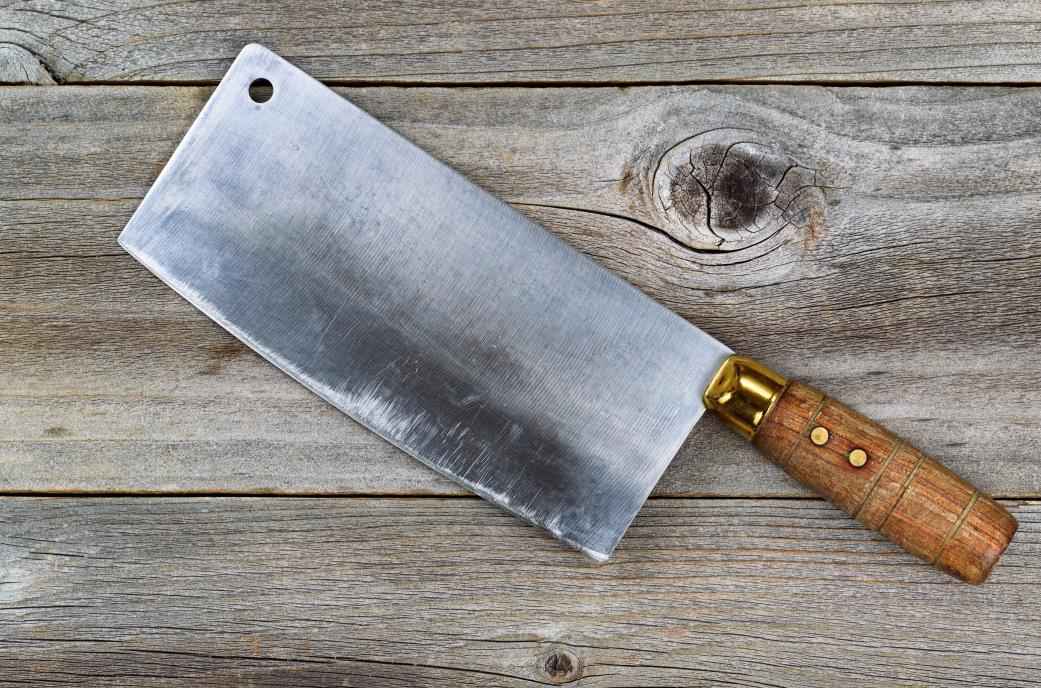
Most cleavers are one-handed knives with an offset handle. A good handle makes a real difference in how a knife feels in the hand, how easy it is to use, and how simple it is to cut with.
Our recommended choice of material for a cleaver handle is wood. Wooden handles come in a wide variety of styles and look great, but the main reason to choose a wooden handle is feel. Wooden handles are more forgiving on the hand and tend to dampen the force of repeated impacts, which is useful when you’re cutting through thick joints and bones.
It’s also worth looking at the blade’s tang when you’re purchasing a knife. The tang is the part of the blade that extends into the handle. You should always buy a full-tang knife, where the blade extends fully to the handle’s bottom, as they’re much stronger and less prone to breaking.
Size and weight
Like all knives, cleavers come in a variety of different sizes. The average Western cleaver has a blade that’s between 6 to 10 inches long and around 3 to 4 inches deep. Asian style cleavers can also be around this size, especially larger, meat cutting blades like a Gudao, but tend to run slightly smaller on average.
Cleavers are heavy knives, and that’s by design. The heavier blade puts more weight behind the cutting edge, making it easier to chop through what is being prepared, and meaning that you have to put less force into each swing.
This weight should be balanced. Smaller chefs might not want a cleaver that sits on the heavier end of the scale, because repeated swings might lead to muscle fatigue or loss of control of the blade. If you’re a smaller person, consider buying a lighter knife that is easier to handle.
Budget
We all want the best tools for our kitchen, but no one has an unlimited budget. But as a general rule when buying a cleaver, it’s best to spend a little more, if you can.
Cleavers are designed to last, and the blade design lends itself to a tool that is resilient and robust. This means it’s generally worth investing in a decent cleaver, as they are tools that shouldn’t need replacing for a long time if looked after correctly.
FAQs
Why do Cleavers have a hole?
The hole in a western-style cleaver serves two purposes. Storage and ease of cutting.
The main use of the hole in a cleaver is to make it much simpler to store. Most cleavers aren’t going to fit on a knife rack or in a drawer. The hole lets a cleaver be hung up on a meat hook or overhead tool rack, which leaves the handle in easy reach, but keeps the cleaver safely out of the way when it’s not in use.
The second big use of the hole is to make a cleaver easy to use. Sometimes, when cutting through bone or thick pieces of meat, a second hand on the blade can give you a lot more leverage and force. Wrapping a finger or thumb through the hole in the blade stabilizes it, meaning that you can safely apply more force without risking the blade slipping, or more easily pull the blade free out of a heavy joint of meat.
What’s the best way to store a cleaver?
We recommend two ways to store your cleaver. The first is using the hole in the blade, if it has one, to hang your cleaver from any overhead storage you have available.
The second option is a magnetic storage strip. While cleavers are heavy, a strong magnetic strip or block will comfortably hold any reasonably sized knife. You can read our guide here for more information on how to store your knives.
What is the best way to keep a cleaver sharp?
The good news is, cleavers are relatively simple knives to keep sharp, because of the thick blade and relatively blunt cutting edge. You can sharpen a cleaver in the same way you would any other high-quality kitchen knife, using a knife sharpener or a whetstone.
Final thoughts
There’s a knife for every job, and hopefully this article has taught you everything you need to know about cleavers, their uses, and which one is the right choice for you. If you’re looking for a beautiful, high-quality knife to add to your kitchen, you should check out our store.












